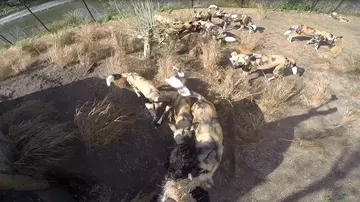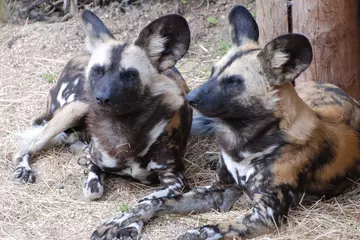Built for speed and agility, African wild dogs are one of the most successful predators on the African savannah.
Their distinctive patterning helps camouflage them from potential prey before they use their incredible stamina and determination to outrun animals such as impalas, gazelles and wildebeest.
Despite their amazing evolutionary adaptations, there’s thought to be only 700 packs of African wild dogs remaining in the wild due to habitat fragmentation and human conflict. The species is currently listed as Endangered, with their population continuing to decrease.
ZSL is not only leading the way in the conservation of African wild dogs in a range of countries, but the pack at London Zoo is also part of the international breeding programme, which helps to maintain a healthy, and genetically diverse population of the species in a safe environment. As one of the most endangered large carnivores in Africa, they are an incredibly important species cared for in zoos.
At London Zoo, we’re extremely lucky to have a 14-strong pack of African wild dogs, after a litter of 11 pups were born to mum Branca and dad Kruger in October 2015; the first at the Zoo in almost 80 years.
Now almost fully grown, keepers have been working with the pack to help encourage their natural behaviours, with a focus on the impressionable and quick-learning youngsters.

The enclosure has been specifically designed to offer them as natural environment as possible, with plenty of foliage for hiding and a mixture of soil and sands for them to dig up, but it gets really exciting when it comes to feeding time.
Keepers use a 30m long zip line to simulate a hunt in the wild, with meat being suspended from the line before travelling through the enclosure for the pack to chase and pull down – just as they would hunt a large animal in Africa. In any given week the group will get through almost 200kg of meat, consisting of carcasses, joints, and rabbits.
“Here at London Zoo we encourage natural behaviours by providing large carcasses for the pack to feed on, this allows hierarchies to form as well as cooperation among the pack when negotiating large ‘prey’. We have a zip line that is used to hang the carcasses from in order to simulate a hunt, as well as making it harder and more stimulating for the dogs to obtain their feed,” says keeper Luke Harvey.
“During a recent zip line feed we saw Selous, our subordinate male, chasing down the ‘prey’ and once he’d caught it, the pups were allowed to get straight in, working in small teams to try and strip the carcass of meat. The pups took turns, with the adults coming in and out to feed.
“Throughout the feeding, the pups compete, work together and take turns to feed – all replicating natural feeding seen in the wild. It’s great to see the adults mostly holding back and allowing the pups to eat first, yet when they do want to feed, taking control.”

As well as enriching our African wild dogs with a similar diet they’d get out in the wild, the team also work extremely hard to incorporate a number of other activities into their enclosure to stimulate the pack and keep them active.
Keeper Luke Harvey explains: “We create blood trails around the paddock and hide pieces of meat, encouraging problem solving, digging and climbing – which keeps the dogs active and healthy. Enrichment items such as boomer balls (large, hollow balls) and tubes are put in, sometimes with meat, blood or scents, for them to play with and stimulate the senses.
“Hessian sacks filled with bedding from animals like the giraffes and okapi in the Zoo are also popular with the playful youngsters, as the smells are something new for them to investigate.
“The pups are very inquisitive and extremely active, they readily interact with everything that has been offered so far, as well as interacting with the enclosure furnishing, tearing up logs and playing in the long grasses and trees.”
All of the enrichment work done by the team aims to stimulate both mental and physical activity within the pack. Our adult African wild dogs are also involved in an advanced training programme which allows individual name recognition/recall to a station, where they asked to sit, lie down or stand up, so keepers can carry out full body visual inspections.
This training helps desensitise the dogs to touch, so the animals voluntarily receive injections. As a result of this work, keepers can carry out vaccinations in a relaxed setting - without the animals needing to pay a visit to the vets.
Watch the video below to see how our pack being fed using the zip line.
You can see our pack of African wild dogs in our Into Africa section on the north side of the Zoo.
